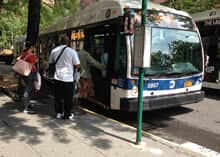Getting around New York City can be overwhelming at first; with all the people and sites to see, it might be difficult to imagine how everyone travels from location to location. You’d be surprised, however, at just how easy it is after a few practice trips and just a little bit of planning.
Plus, there are dozens of smartphone apps that will help you should you require additional assistance in understanding the travel systems. Programs like Google Maps and the MTA app can help you find your way and can even tell you how long it will take.
Subways
The subway is the easiest, fastest, and arguably the most convenient way to travel within the city limits. With 25 lines that can take you to the Bronx, Brooklyn, Queens, or Manhattan, you can go practically anywhere. Available 24 hours a day, the subway lines run through and to almost every neighborhood in New York City, and subway cars come minutes within each other, so if you miss one, another will be on the way.

The subway is also one of the most financially reasonable ways to commute throughout the city with different price packages available depending on your needs. The best part of the subway is that the lines are underground, so you can avoid street traffic, weather elements, and even pedestrians—all of which can significantly delay your commute. Depending on how frequently you travel via the subway and/or the bus, there are multiple packages you can purchase. You can pay per ride, which is $2.75, but this can add up and be quite pricey, so most people purchase either a 7-day or 30-day pass. The 7-day unlimited pass means you can ride as often and frequently as you’d like for these 7 days for $32.00. For people like me that take the subway every day of the week, I opt for the monthly unlimited pass for $121.00.
Buses
This is another great option for traveling within the city limits. Just like the subway, this method of travel is cost effective (the payment packages are identical to the subway and even requires the same card) and pretty reliable. With over 300 bus routes, you may find that you actually have more options than the subway. The one thing to keep in mind is that speed may not be on your side with this method of transportation, as the buses not only have to deal with the street traffic, but there are many more stops on the bus lines, so if you’re traveling and pressed for time, it’d be best to stick to the subway.

Taxis
These cars are everywhere in New York City and impossible to miss. Bright yellow, these vehicles will pick you up on the curb and take you directly to your final destination. While this option is highly convenient, it can also be pretty expensive depending on how far you’re traveling. The rate is calculated by time and distance, so if you’re noticing that traffic is heavily congested and you have a far way to travel, it might be better to go for the subway or a bus.

Car Services (Uber, Via, Lyft, Gett)
You might find yourself using these often, as you can request a ride directly from your phone and have the car drop you off at your destination. These services tend to be cheaper than taxis and are often more prevalent. Another great feature is that you can sync your credit card within the app so you don’t have to fumble with your wallet at the end of your trip. Depending on your need, some services will allow you to share your ride with other New Yorkers to help alleviate the cost. Via will take you anywhere in Manhattan for $5, but beware—the driver might pick up other riders along the way, so if you’re in a hurry, perhaps choose a service that will be designated just for you.
Walk
But of course, if the weather permits and you have comfortable shoes on, walking could easily be your best option. New York City is one of the most fantastically scenic cities in the world, and taking the long way home is a great way to take in the sites and learn the neighborhoods. Plus, while you’re on foot, this is the perfect time to pay attention to the bus stops, the subway lines, and watch how people flag taxis down—this is a great way to brush up on your commuting knowledge. Plus, it’s free!
